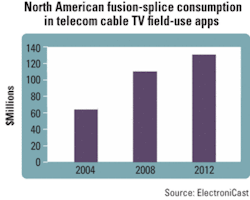Fusion-splicer demand, applications growing
The most critical aspects of optical-fiber implementation are the joining of fibers with minimal signal loss and reflections as well as providing a mechanically stable connection. The conventional methods include using fiber-optic mechanical connectors, mechanical splice, and fusion. For multimode systems with adequate power budget and few connections, mechanical connectors and splices are the preferred methods. For ultra-low-loss joints (on the order of a 0.05-dB average), particularly in singlemode applications, fusion splicing is the answer, despite higher capital equipment cost when relatively few splices are needed.
In contrast to mechanical splicing, fusion splicing typically offers superior return loss and tensile strength, better overall environmental stability, and lower consumable cost. However, fusion splicing requires larger initial capital investment and a higher cost in trained personnel. Fusion splicing has had more appeal in long-haul telephony markets where multiple fibers, located typically in buried environmentally controlled vaults, are spliced. Mechanical splicing or even low-loss fiber-optic connectors become more economical when a relatively lower number of fibers must be spliced (or connected).
Fusion-splice equipment manufacturers have developed handheld units that perform active splice alignment to achieve virtually 0-dB fusion splices. An economical handheld micro-fusion splicer can cost less than $4,000, particularly in volume. At this cost, the single-fiber micro-fusion or mini-splicers pay for themselves after about 1,000 single-fiber splices versus the mechanical-splice alternative; after that, the cost is primarily driven by the price of the fusion-splice protective sleeve.
There are two major fiber-optic fusion splicing technologies: core alignment and cladding alignment. Core-to-core aligning involves positioning of the fiber cores; thus, this technology splices with higher precision than cladding-to-cladding. Two methods of aligning the optical-fiber cores to complete a fusion splice are typically employed: local injection and detection (LID) and lens-profile alignment. Core alignment splicers evaluate the video images in the X and Y planes (lens-profile alignment) from an integrated charged-coupled-device camera utilizing a microprocessor-controlled image processing system. Then the LID technique is used to provide an exact core-to-core alignment of the optical fibers in the X and Y directions. Fixed-fiber (cladding) alignment of multiple fibers is also an option with these devices.
For applications that don’t require the high precision of core-to-core alignment, splices can be engineered by aligning the outer cladding diameter of the optical fibers. Typically in such splicers, the technician fits the fibers in a V-groove guide (one on each side) and/or uses video imaging to view the outer diameter of the fibers. The splicer then brings the fibers together so they appear to be properly aligned. The cladding outer diameter alignment method has become increasingly effective as fiber quality has improved, since the cores of optical fibers have become more consistently located in the center of the cladding. Therefore, if the cladding is positioned in a similar alignment, the cores will also have a similar alignment. Of course, if the cores are not in the same location within the fiber cladding, the cores may not have a sufficient matching alignment for a good splice.
The difference between the core’s actual positions relative to the actual center of the fiber is referred to as the core offset. Not all optical fibers are manufactured to be exactly identical; therefore, differences in the actual fiber diameter, coatings, and fiber curl cause the cladding method to be less efficient than the core-to-core method. Both the core-to-core and the cladding techniques can produce a quality fusion splice. Splice loss and return loss measurement vary by technique; therefore, some techniques are more appropriate for specific applications.
Multimode optical fiber is aligned by its outer diameter, since its large core size makes core-to-core alignment unnecessary. Also, premises data networks can accommodate greater splice losses; therefore, cladding technology is sufficient. Premises data networks, typically multimode, also are usually inside and the optical fiber is easily accessible versus outside aerial telecommunications and cable TV. Therefore, the fusion splicers used for premises applications can be less expensive and less rugged than their outdoor counterparts. In fact, typical mechanical splices are sufficient for most premises applications.
Telcos and other major network operators with the larger trunk cables (and therefore higher fiber counts) of “loose ribbon” configurations, make the fusion splicer much more cost-effective in high-volume use. The North American value, for example, of selected fiber-optic fusion-splice equipment used in telecommunications and cable TV field-use applications was $64 million last year. ElectroniCast forecasts the consumption value to increase to $110 million in 2008, with strongly rising quantity growth partially offset by a continuing decline in average prices (see Figure). By 2012, ElectroniCast predicts the North American value of selected fiber-optic fusion-splice equipment used in telecommunications and cable TV field-use applications will reach $131 million.Stephen Montgomeryis president of ElectroniCast (San Mateo, CA) and director of the company’s Fiber Optics Components and Network Communication Products groups. He also is a member of Lightwave’s Editorial Advisory Board.

